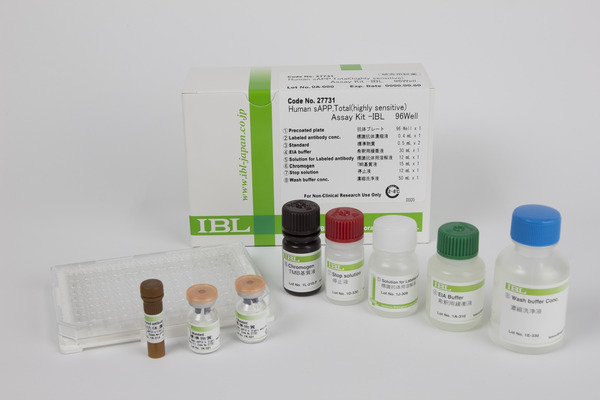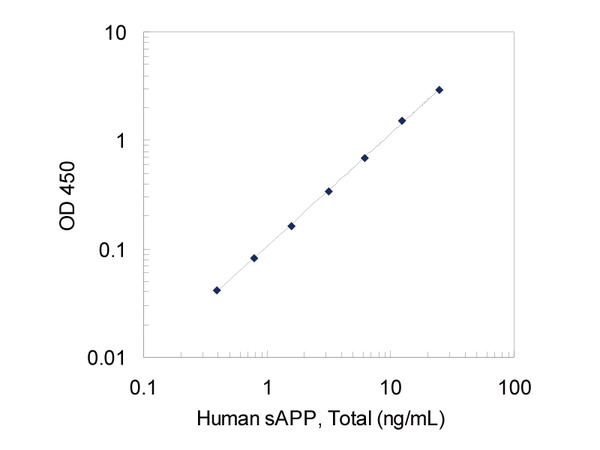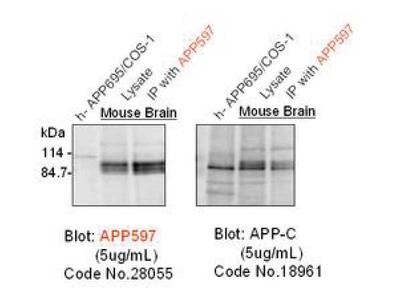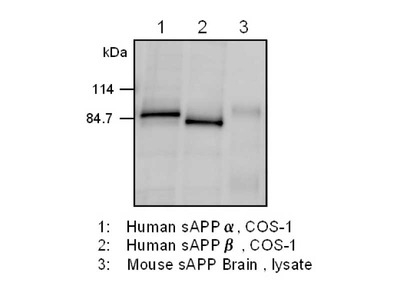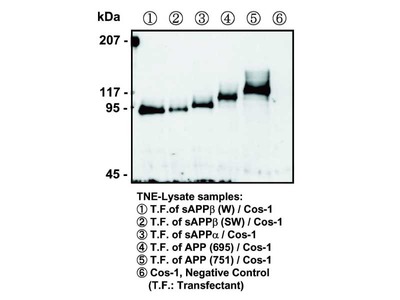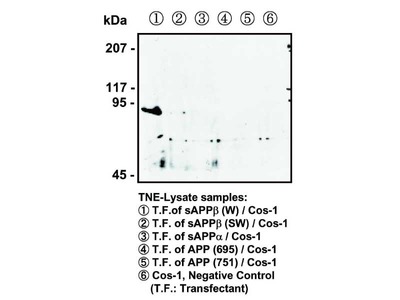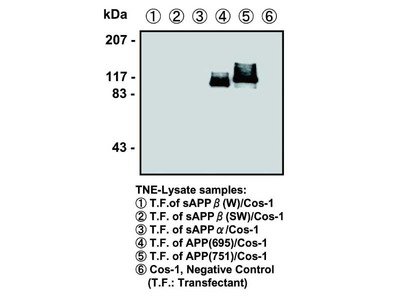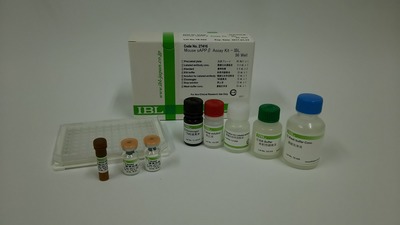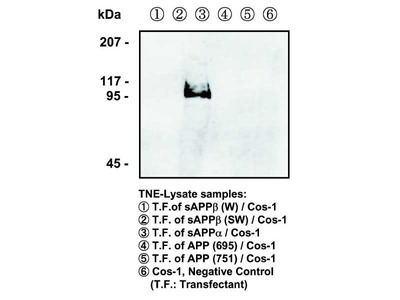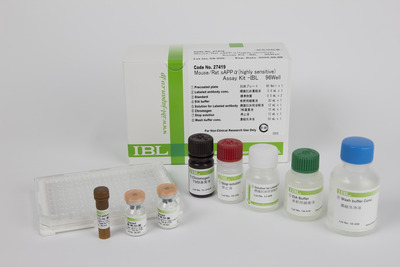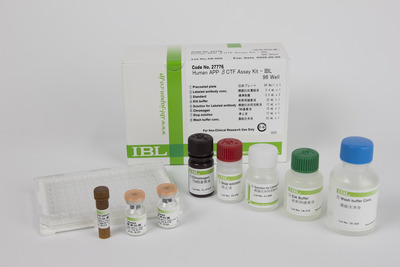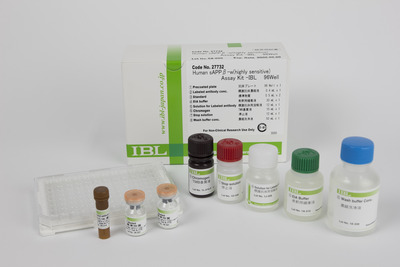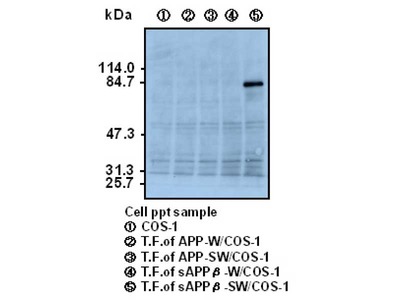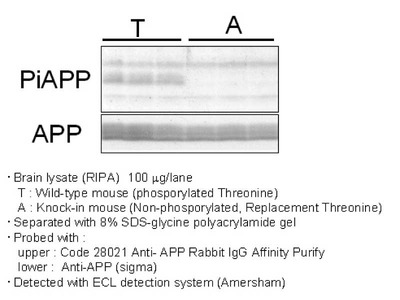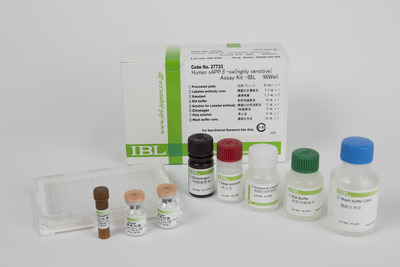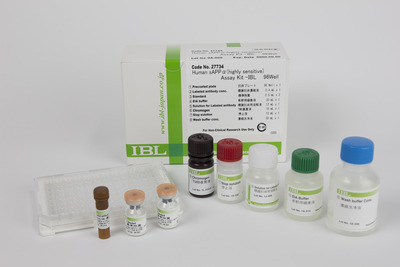- HOME >
- For Researchers >
- Product Search >
- Search Result >
- #27731 Human sAPP, Total (highly sensitive) Assay Kit - IBL
Product Search
#27731 Human sAPP, Total (highly sensitive) Assay Kit - IBL
- Intended Use:
- Research reagents
- Measuring Method:
- ELISA
- Sample Types:
- Human
- Measuring Samples:
- EDTA-plasma, Serum, CSF, Cell culture supernatant
- Measurement Range:
- 0.39 - 25 ng/mL
- Package Size1:
- 96 Well
※ The product indicated as "Research reagents" in the column Intended Use cannot be used
for diagnostic nor any medical purpose.
※ The datasheet listed on this page is sample only. Please refer to the datasheet
enclosed in the product purchased before use.
Product Overview
Product Overview
| Product Code | 27731 |
|---|---|
| Product Name | Human sAPP, Total (highly sensitive) Assay Kit - IBL |
| Intended Use | Research reagents |
| Measuring Method | ELISA |
| Conjugate | HRP |
| Species | Human |
| Measuring Samples | EDTA-plasma, Serum, CSF, Cell culture supernatant |
| Measurement Range | 0.39 - 25 ng/mL |
| Primary Reaction | Overnight at 2 - 8 ℃ |
| Secondary Reaction | 30 minutes at 2 - 8 ℃ |
| Sensitivity | 0.06 ng/mL |
| Specificity | Compound Cross Reactivity Human sAPPα 100.0% Human sAPPβ-wild type 100% Human sAPPβ-swedish type 100% |
| Storage Condition | 2 - 8 ℃ |
| Poisonous and Deleterious Substances | Not Applicable |
| Cartagena | Not Applicable |
| Measuring Service | Not Available |
| Package Size 1 | 96 Well |
Product Description
Product Description
Alzheimer's disease (AD) was first reported by A. Alzheimer, a German neuropathologist in 1907 and is considered as a major factor of dementia. It is known that Amyloid β (Aβ; which is major constituent of senile plaque) is cleaved from Amyloid Precursor Protein (APP; which exists in three main isoforms, APP695, APP751, and APP770) by β-secretase and subsequent γ-secretase. The production of soluble APPβ (sAPPβ) by β-secretase cleavage corresponds to Aβ production accordingly, so it is desired to measure sAPPβ in parallel with Aβ. In addition, it is reported that APP gene mutation exists in individuals who suffer early-onset familial Alzheimer’s disease. Swedish mutation, one of the APP gene mutations, is a double mutation at positions -1 to -2 from the β-secretase cleavage site (Lys670→Asn and Met671→Leu). And further, it is reported that Swedish mutation elevates Aβ40 and Aβ42 production, and that the mutation is utilized in establishment of transgenic mice. The measuring sAPPβ in Swedish type is useful for research of AD as well as in wild type. On the one hand, it is considered that in the metabolic pathway of APP, APP is first cleaved by α-secretase rather than β-secretase normally to produce soluble APPα (sAPPα) and subsequently P3 is cleaved from the remaining C-terminal fragment by γ-secretase. This kit can measure human soluble APP in samples as a total amount including sAPPα and sAPPβ. IBL has many other kinds of Amyloidβ-related products for AD research. They are very specific assay systems for each target and they can be used according to the purpose of study.
FAQ
FAQ
-
 Q.What type of soluble APP can be measured by this kit?
Q.What type of soluble APP can be measured by this kit? -
 A.This kit cross reacts to any type of human soluble APP.
A.This kit cross reacts to any type of human soluble APP. -
 Q.Is composition of EIA buffer of each ELISA kit all same? Can it be mixed to use?
Q.Is composition of EIA buffer of each ELISA kit all same? Can it be mixed to use?
ELISA common FAQ -
 A.No it isn't. As constitute of each EIA buffer is different, it cannot be mixed with other lots or EIA buffers contained in other kind of ELISA kits.
A.No it isn't. As constitute of each EIA buffer is different, it cannot be mixed with other lots or EIA buffers contained in other kind of ELISA kits. -
 Q.What is the composition of concentrated wash buffer?
Q.What is the composition of concentrated wash buffer?
ELISA common FAQ -
 A.It contains ordinary Tween and phosphate buffer (0.05% Tween-20 in PB).
A.It contains ordinary Tween and phosphate buffer (0.05% Tween-20 in PB). -
 Q.What is the feature of the plate?
Q.What is the feature of the plate?
ELISA common FAQ -
 A.We use plate that is flat bottom and removable strip type plate (8wellx 12 strips).
A.We use plate that is flat bottom and removable strip type plate (8wellx 12 strips). -
 Q.Can I re-use standard after reconstitution?
Q.Can I re-use standard after reconstitution?
ELISA common FAQ -
 A.Not recommended to re-use standard after reconstitution. Please use it at once after the reconstitution.
A.Not recommended to re-use standard after reconstitution. Please use it at once after the reconstitution.
Please note that there are some exceptions. One time freeze-thaw the standard is acceptable for use after reconstitution for some ELISAs.
Please check the details on each product datasheet. -
 Q.What is different between reagent blank and test sample blank?
Q.What is different between reagent blank and test sample blank?
ELISA common FAQ -
 A.Reagent blank means a well is only added EIA buffer and the purpose is confirming whether the Test sample value is influenced by lack of washing process or other operations. Test sample blank means a well is added EIA buffer and HRP antibody and the purpose is to calculate the background.
A.Reagent blank means a well is only added EIA buffer and the purpose is confirming whether the Test sample value is influenced by lack of washing process or other operations. Test sample blank means a well is added EIA buffer and HRP antibody and the purpose is to calculate the background. -
 Q.How many samples can be measured by this kit?
Q.How many samples can be measured by this kit?
ELISA common FAQ -
 A.The pre-coated plate contained in our ELISA kit is 96 wells plate. We recommend to use 16 wells (2 slits) for standard and 80 wells (10 slits) for 40 samples in duplicate.
A.The pre-coated plate contained in our ELISA kit is 96 wells plate. We recommend to use 16 wells (2 slits) for standard and 80 wells (10 slits) for 40 samples in duplicate. -
 Q.What is LOD (Limit of Detection)?
Q.What is LOD (Limit of Detection)?
ELISA common FAQ -
 A.It (LOD) is defined as sensitivity that is calculated using the NCCSL method. Please refer to a datasheet of each product.
A.It (LOD) is defined as sensitivity that is calculated using the NCCSL method. Please refer to a datasheet of each product. -
 Q.What is LOQ (Limit of Quantification)?
Q.What is LOQ (Limit of Quantification)?
ELISA common FAQ -
 A.It (LOQ) is the lowest value of measurement (standard) range. Please refer to a datasheet of each product.
A.It (LOQ) is the lowest value of measurement (standard) range. Please refer to a datasheet of each product. -
 Q.What is the definition of Over Night (O/N) reaction?
Q.What is the definition of Over Night (O/N) reaction?
ELISA common FAQ -
 A.It means that the reaction is required more than 16 hours unless otherwise specifically defined it on a datasheet of each ELISA product.
A.It means that the reaction is required more than 16 hours unless otherwise specifically defined it on a datasheet of each ELISA product. -
 Q.What is the specification of quality control for ELISA product release?
Q.What is the specification of quality control for ELISA product release?
ELISA common FAQ -
 A.The information of specification is available on individual lot specific CoA. Please contact us with your reference lot number for obtaining of specific CoA.
A.The information of specification is available on individual lot specific CoA. Please contact us with your reference lot number for obtaining of specific CoA. -
 Q.What is the number (e.g. 432143214321) at the edge of strips of the plate?
Q.What is the number (e.g. 432143214321) at the edge of strips of the plate?
ELISA common FAQ -
 A.According to the plate maker (ThermoFisher), it does not have any specific meaning as it is just the number of molds.
A.According to the plate maker (ThermoFisher), it does not have any specific meaning as it is just the number of molds. -
 Q.How to wash an ELISA plate?
Q.How to wash an ELISA plate?
ELISA common FAQ -
 A.Washing it by an auto-washer is highly recommended.
A.Washing it by an auto-washer is highly recommended.
If it is not available, please refer to the demo video (only 2 mins) using a washing bottle. -
 Q.The wells turned black during the test with the kit.
Q.The wells turned black during the test with the kit.
ELISA common FAQ -
 A.It is possible that the wells were not washed sufficiently during the washing process after the HRP-labeled antibody reaction.
A.It is possible that the wells were not washed sufficiently during the washing process after the HRP-labeled antibody reaction.
Be sure to wash the wells enough times as described in the data sheet with washing buffer of more than 350 µL.

